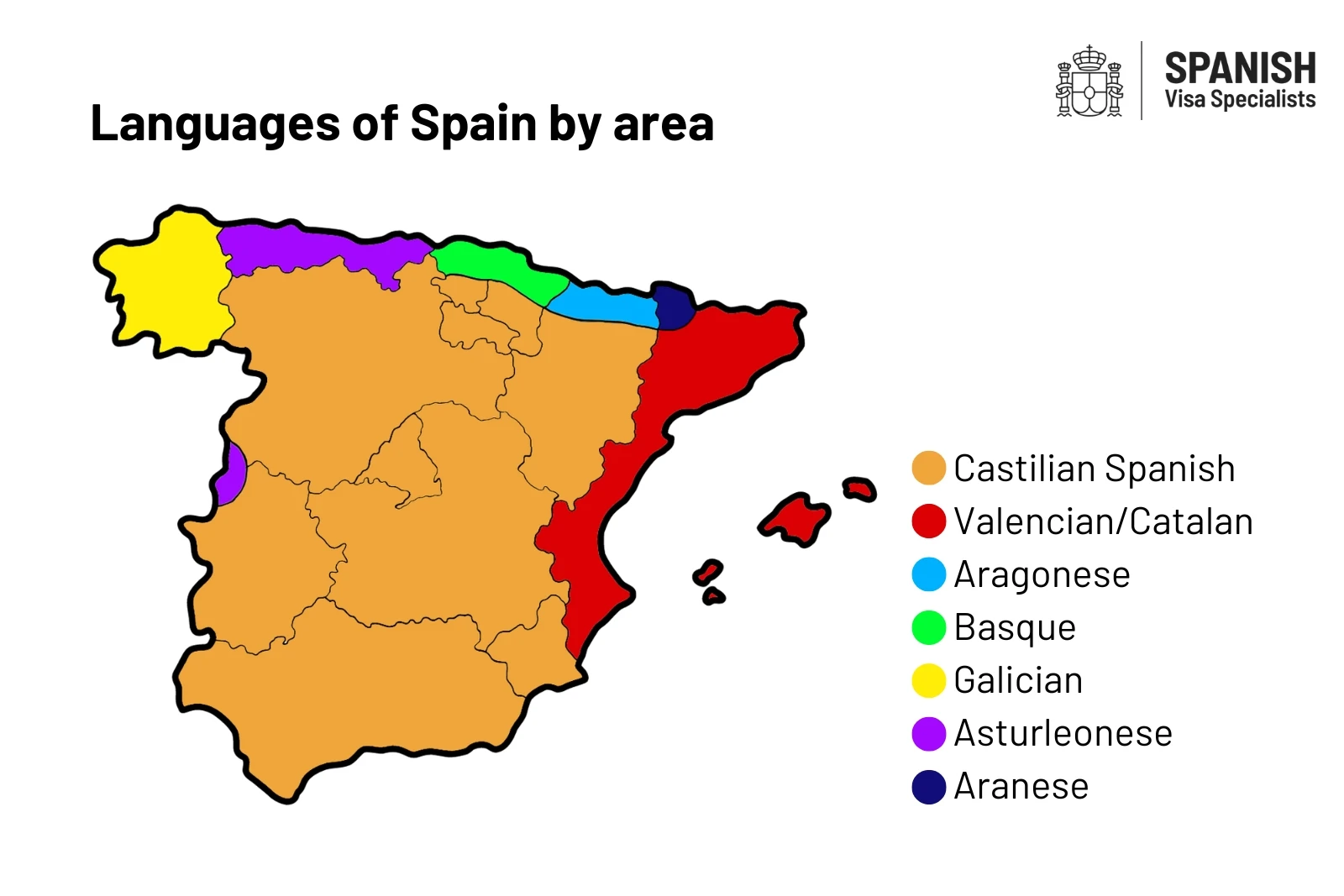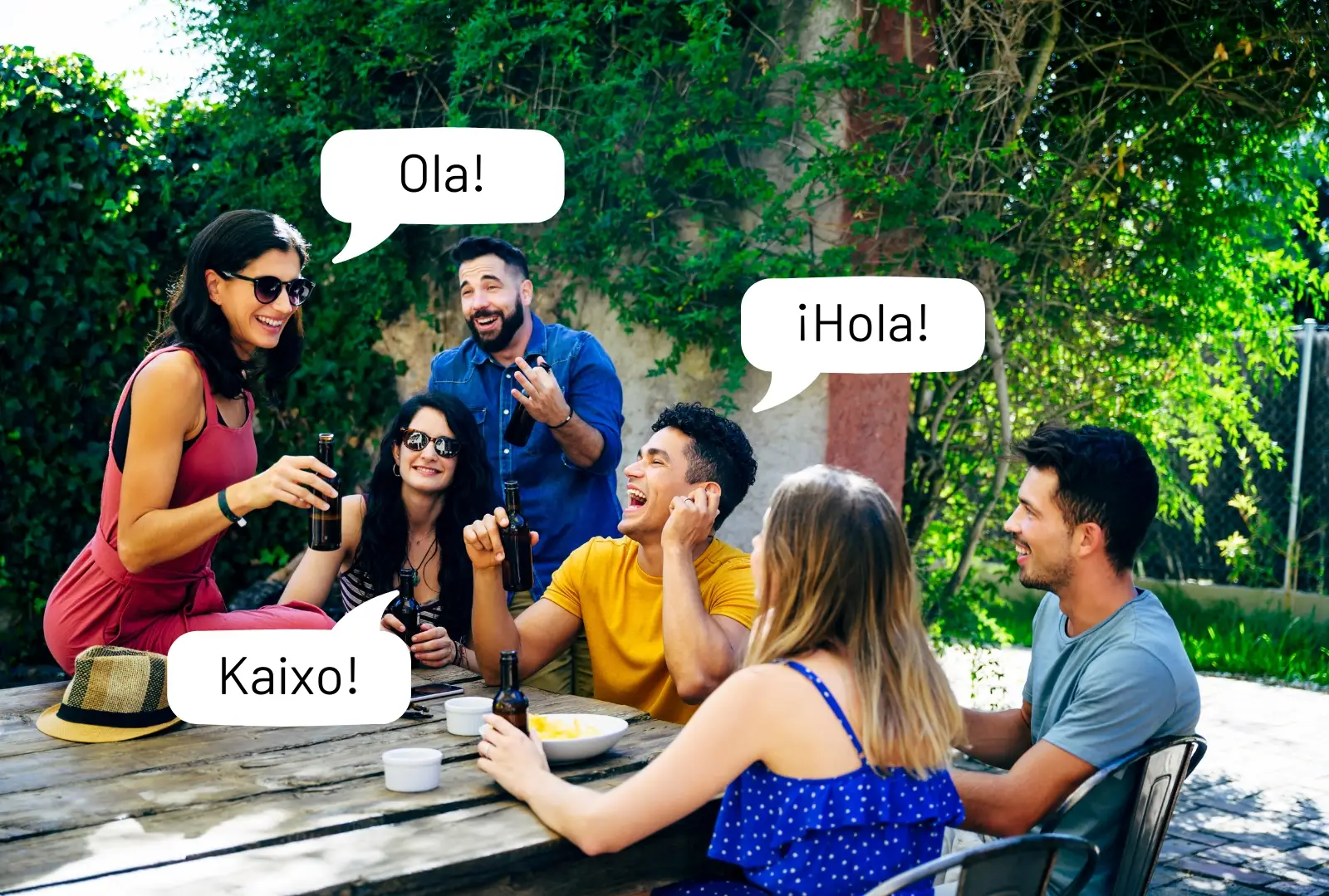Spanish is the second most spoken first language in the world, and the fourth most spoken language overall with 559 million global speakers.
With it being such a common language, you will already know about Spanish, and may even recognise a few words just from school or by seeing them used online or elsewhere. However, it is not the only language that calls Spain home.
There are several languages in Spain, some of which have millions of speakers. If you plan on going to Spain to work, study, or even just for a holiday, it may be useful to be aware of the other languages spoken there.
Gaining knowledge of Spain’s other languages will help to immerse yourself in regional cultures, allow you to connect more with the locals which may even impress them with your surprising knowledge, and also help keep these languages alive. If you are wondering: ‘what languages are spoken in Spain?’ then read on to find all about Spain’s major languages, as well as some of its smaller ones.
Castilian Spanish
Before we discuss the other languages spoken in Spain, we will explore the history of the Spanish language instead.
In the centuries before Spain was formed, it was split into different nations that rose, fell, or merged together. One of the major and most powerful nations was Castile, which was home to the Castilian language. Castilian is a Romance language with roots in Vulgar Latin.
Eventually, the Crown of Castile entered a dynastic union with the Crown of Aragon in 1479, which laid the foundations for the formation of Spain, and the Spanish Empire. The two combined crowns became known as Spain, though they were still both in existence. This ended after the War of the Spanish Succession which lasted from 1701 to 1714, and resulted in the Crown of Aragon being dissolved.
Essentially, Castile became the centre of the Kingdom of Spain, and their language was the dominant one spoken. Castilian was also spoken in the many colonies of Spain; the modern nations descended from these colonies all have their own versions of Spanish, such as Mexico.
Castilian Spanish is the original, and still the variant of the language spoken in Spain today. It is the language you will find the most useful when you spend time all across Spain, as the majority of people will know and understand it. If you are interested in learning Spanish, please read our blog on six of the best ways to learn Spanish.
Catalan and Valencian
The second most spoken language in Spain is Catalan, or Català as its native speakers call it. Catalan is a Romance language and has 10 million speakers. It is a co-official language with Castilian Spanish in Catalonia, the Balearic Islands, and is a recognised minority language in Aragon, and even parts of France and Italy. It is also the official language of Andorra, which is the only independent nation to have Catalan recognised as such.
Due to the peculiarities of the linguistic world, there is also the Valencian language, which is the co-official language of Valencia alongside Catalan and Castilian Spanish. However, Valencian, or Valenciano as it is known in the language, is also technically a variant of Catalan. The two languages are an example of how the lines between a dialect and a language can be blurred, but we are putting them together due how closely related they are.
Catalan, just like Spanish, has its roots in the versions of Vulgar Latin that were spoken in the Iberian Peninsula after centuries of Roman ownership. Catalan appeared roughly between the eighth and tenth centuries, but the earliest known texts are from the 12th century.
Many people consider Catalan to sound like it is somewhere between Spanish and French, with some bits sounding Italian as well. It is a unique language that bridges a gap between other Romance languages.
If you go to areas where Catalan or its Valencian variant are widely spoken, it would be a good idea to learn some words, as not everyone you talk to will necessarily be fluent in Spanish.
Galician
Next is another Romance language called Galician, or Galego as it is known to its speakers. This language is native to Galicia, which is the region of Spain that borders Portugal to the north. Galicia was even its own kingdom once, so Galician would have been the primary language of this country.
There are around three million speakers of Galician, with most speakers being in Galicia. However, there are also speakers in the neighbouring regions of Asturias, Castile, and León.
Galician is old just like the other languages in this guide, with its roots also being in the variants of Vulgar Latin spoken throughout the Iberian Peninsula. Its earliest known recorded texts come from the 13th century.
The range of the Galician language not only borders Portugal, but it is also linguistically linked to Portuguese. The two originate from the same language, known as Galician-Portuguese. This language eventually split into two languages, along with some other smaller ones.
Although they split centuries ago, Galician and Portuguese are still mutually intelligible, so speakers of both can communicate with each other without much difficulty.
Galicia still maintains its own unique cultural identity, which its language is still a part of. If you plan on visiting Galicia, we recommend trying to learn a few words to both connect with the local people, and so you can better immerse yourself in Galicia’s culture.
Basque
By far the oldest and most unique of the languages spoken in Spain is the Basque language, or Euskara as it is known to the Basque people.
Unlike the other major languages spoken in Spain, Basque is not a Romance language. In fact, it is not related to any living language anywhere in the world.
Basque is in the Paleo-European language family, and is the last remaining language of the ancient peoples who lived in Europe before even the earliest Indo-Europeans who make up most of Europe today arrived thousands of years ago.
Whilst all other pre-Indo-European peoples and languages became subsumed into the cultures of the early modern European peoples, the Basque persisted. It is impressive that after so many centuries with threats of invasion, Spanish rule and other influences, that they have managed to survive and keep going.
There are 750,000 native speakers of Basque, with most of them being in the Basque Country of Spain, and a smaller number in Navarre.
Navarre is also where the oldest known Basque text was discovered, known as the Hand of Irulegi. It is thought to be over 2000 years old, so around a thousand years older than the earliest texts of the other languages we have discussed so far.
Learning some Basque would likely be much more difficult than the Romance languages of Spain, as there are some similarities between them and English. Also, you will be more familiar with Romance languages due to being exposed to them from a young age.
However, it could be rewarding to gain some knowledge of such an ancient and persistent language. You would be able to better connect with the people who have called the Basque Country home since before even the Romans arrived in the Iberian Peninsula, and gain a unique insight into their culture.

Minor languages of Spain
So far, we have gone through the four (or five, depending on how you view Valencian) languages in Spain that are widely spoken.
However, they are not the only languages. Spain’s history has resulted in there being various other languages, some of which used to be more widespread than they are today. Then, there are the languages that are spoken in territories outside of mainland Spain.
Aragonese
Although it shares a name with the once powerful Crown of Aragon, Aragonese today is spoken by only around 12,000 native speakers in the Pyrenees mountains. It is not even widely spoken in the region of Spain with which it shares its name.
Like most of the other languages mentioned, it is a Romance language. It shares quite a few similarities with Spanish, which has slowly taken over its native range over the years.
Aranese
Perhaps one of the least known languages in Spain is Aranese. This Romance language is found in the only part of Spain that is north of the Pyrenees, in a valley that is home to a place called Val d’Aran. Here, the Aranese people and speakers can be found. There are only 10,000 people living here, but they have managed to maintain their own unique language and culture, despite being a part of Catalonia for centuries.
Aranese is related to Occitan, which is spoken in parts of southern France.
Asturleonese
Within Spain itself is yet another Romance language, which is made up of Asturian and Leónese dialects spoken in Asturias and Spain respectively. The first Christian Iberian kingdom following the Muslim conquests of Iberia was the Kingdom of Asturias. This small kingdom eventually managed to begin the Reconquista which eventually resulted in the Spain we know today.
The Kingdom of Asturias eventually gave birth to the Kingdom of León, which was at one point the largest kingdom in Iberia. This kingdom eventually merged with Castile, but Asturias and León’s unique dialects can still be found in their own modern regions.
Fala
Fala is one of the other languages that comes from Galician-Portuguese, and it is spoken by just a few thousand people in Jálama. This language is mutually intelligible with Galician.
Maghrebi Arabic
In Ceuta, one of the two cities that Spain controls in mainland Africa, a significant number of people speak a variant of Arabic called Maghrebi Arabic. If you ever plan on visiting Ceuta, you should be aware of the fact that many Moroccan people live there, and many will speak Arabic instead of Spanish.
Portuguese
Spain and Portugal have shared a border for many years. It is only natural that along the border, there are places that primarily speak Portuguese instead of Spanish. Portuguese speakers can be found in small areas such as Cedillo.
Silbo Gomero
Unlike any other language in Spain, and most in the world, Silbo Gomero is a whistled language native to La Gomera in the Canary Islands. It was created as a way to easily communicate through the valleys of the island. It is a unique way of communicating, and is protected by UNESCO.
Tarifit Berber
The other Spanish city in mainland Africa is Melilla. Here, the population can be split between Spanish speakers, and Riffians, who speak Tarifit Berber. Berber languages, or Amazigh as the native speakers call them, are the ancient, native languages of areas that include modern day Morocco, which the Amazigh people speak.
Tarifit is not yet a recognised language in Spain, though there are groups attempting to change this.
Although all of these languages have a small presence in Spain, they are useful to know about, so you can gain an understanding of the many people who make up modern Spain.
How we can help you go to Spain
We hope that this showcase of languages in Spain has taught you something and inspired you to learn more for when you go to Spain.
To go to Spain and make use of your language skills, you will need a visa if you plan on staying for a long period of time, or if you plan on moving permanently. Although we cannot help you with getting a visa itself, we can assist you by preparing your documents for when you apply for one. Furthermore, we can notarise your documents and arrange for them to be legalised, so that you can use them in Spain.
Contact us today to talk to a member of our expert Spanish visas team to see what we can do for you.


